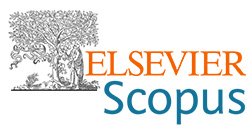Electrochemical evaluation of natural extracts as effective corrosion inhibitors and surface treatments on metal substrates
DOI:
https://doi.org/10.62638/ZasMat1247Apstrakt
Corrosion is a serious problem encountered in the industry, protection from it is more than necessary using inhibitors and treatments. These treatments can effectively ease the problem on the surface of the material substrate, particularly the metal substrate for being easily etched during usage and being unable to withstand abrasion. Experimental results showed that the extracts are effective inhibitors of corrosion. Polarization tests indicate that the inhibitors are of mixed nature and the corrosion mechanism does not change after their addition to the solution. The electrochemical impedance spectroscopy confirmed that inhibitory quality and surface treatments improved corrosion resistance. Surface analysis revealed that the surface of the sample for the control solution was covered and protected. However, for the inhibited solutions the presence of oxides was not observed.
Ključne reči:
corrosion protection, inhibitor, surface treatmentsReference
R. Mohammadi, J. Wassink, A. Amirfazli (2004) Effect of surfactants on wetting of super-hydrophobic surfaces, Langmuir, 20, 9657-9662. https://doi.org/10.1021/la049268k
J.-Y. Shiu, C.-W. Kuo, P. Chen, C.-Y. Mou (2004) Fabrication of tunable superhydrophobic surfaces by nanosphere lithography, Chemistry of Materials, 16, 561-564. https://doi.org/10.1021/cm034696h
M. Sun, C. Luo, L. Xu, H. Ji, Q. Ouyang, D. Yu, Y. Chen (2005) Artificial lotus leaf by nanocasting, Langmuir, 21, 8978-8981. https://doi.org/10.1021/la050316q
H. Yabu, M. Shimomura (2005) Single-step fabrication of transparent superhydrophobic porous polymer films, Chemistry of Materials, 17, 5231-5234. https://doi.org/10.1021/cm051281i
S. Agarwal, S. Horst, M. Bognitzki (2006) Macromolecular materials and engineering, 291, 592-601. https://doi.org/10.1002/mame.200600076
A.A. Aghzzaf, B. Rhouta, E. Rocca, A. Khalil, J. Steinmetz (2014) Corrosion inhibition of zinc by calcium exchanged beidellite clay mineral: a new smart corrosion inhibitor, Applied Clay Science, 80, 46-52. https://doi.org/10.1016/j.corsci.2013.10.037
K. Aramaki (2001) The inhibition effects of chromate-free anion inhibitors on corrosion of zinc in aerated 0.5 M NaCl, Corrosion Science, 43, 591-604. https://doi.org/10.1016/S0010-938X(00)00085-8
J. Aslam, R. Aslam, S.H. Alrefaee, M. Mobin, A. Aslam, M. Parveen, C.M. Hussain (2020) Gravimetric, electrochemical, and morphological studies of an isoxazole derivative as corrosion inhibitor for mild steel in 1M HCl, Arabian Journal of Chemistry, 13, 7744-7758. https://doi.org/10.1016/j.arabjc.2020.09.008
S.K. Bag, S.B. Chakraborty, A. Roy, S.R. Chaudhuri (1996) 2-Aminobenzimidazole as corrosion inhibitor for 70-30 brass in ammonia, British Corrosion Journal, 31, 207-212. https://doi.org/10.1179/bcj.1996.31.3.207
Y. Bai, H. Yu, Z. Li, R. Amal, G.Q.M. Lu, L. Wang (2012) In situ growth of a ZnO nanowire network within a TiO2 nanoparticle film for enhanced dye-sensitized solar cell performance, Advanced Materials, 24, 5850-5856. https://doi.org/10.1002/adma.201201992
E. Balaur, J.M. Macak, L. Taveira, P. Schmuki (2005) Tailoring the wettability of TiO2 nanotube layers, Electrochemistry Communications, 7, 1066-1070. https://doi.org/10.1016/j.elecom.2005.07.014
R. Berenguer, A. La Rosa-Toro, C. Quijada, E. Morallón (2008) Origin of the deactivation of spinel CuxCo3−xO4/Ti anodes prepared by thermal decomposition, Journal of Physical Chemistry C, 112, 16945-16952. https://doi.org/10.1021/jp804403x
B. Bhushan, Y.C. Jung, K. Koch (2009) Micro-, nano- and hierarchical structures for superhydrophobicity, self-cleaning and low adhesion, Philosophical Transactions of the Royal Society A, 367, 1631-1672. https://doi.org/10.1098/rsta.2009.0014
D. Bose, O. Mehra, C. Gupta (1985) Preparation of rare earth-silicon-iron alloy by metallothermic reduction, Journal of the Less Common Metals, 110, 239-242. https://doi.org/10.1016/0022-5088(85)90327-3
C. Comninellis, A. De Battisti (1996) Electrocatalysis in anodic oxidation of organics with simultaneous oxygen evolution, Journal de Chimie Physique, 93, 673-679. https://doi.org/10.1051/jcp/1996930673
C.G. Dariva, A.F. (2014) Corrosion inhibitors: principles, mechanisms and applications, Developments in Corrosion Protection, 16, 365-378. https://doi.org/10.5772/57255
P. de Lima-Neto, A.P. de Araujo, W.S. Araujo, A.N. Correia (2008) Study of the anticorrosive behaviour of epoxy binders containing non-toxic inorganic corrosion inhibitor pigments, Progress in Organic Coatings, 62, 344-350. https://doi.org/10.1016/j.porgcoat.2008.01.012
C. Deya, G. Blustein, B. Del Amo, R. Romagnoli (2010) Evaluation of eco-friendly anticorrosive pigments for paints in service conditions, Progress in Organic Coatings, 69, 1-6. https://doi.org/10.1016/j.porgcoat.2010.03.011
Y. Feng, S. Chen, J. You, W. Guo (2007) Investigation of alkylamine self-assembled films on iron electrodes by SEM, FT-IR, EIS, and molecular simulations, Electrochimica Acta, 53, 1743-1753. https://doi.org/10.1016/j.electacta.2007.08.035
Z. Guo, F. Zhou, J. Hao, W. Liu (2005) Stable biomimetic super-hydrophobic engineering materials, Journal of the American Chemical Society, 127, 15670-15671. https://doi.org/10.1021/ja0547836
B. Hinton, L. Wilson (1989) The corrosion inhibition of zinc with cerous chloride, Corrosion, 29, 967-985. https://doi.org/10.1016/0010-938X(89)90087-5
D. Jang, C.T. Gross, J.R. Greer (2011) Effects of size on the strength and deformation mechanism in Zr-based metallic glasses, International Journal of Plasticity, 27, 858-867. https://doi.org/10.1016/j.ijplas.2010.09.010
F. Jianqing, Y. Huipin, Z. Xingdong (1997) Promotion of osteogenesis by a piezoelectric biological ceramic, Biomaterials, 18, 1531-1534. https://doi.org/10.1016/S0142-9612(97)80004-X
A. Kaouka, O. Alaoui (2019) Characterization and corrosion resistance of boride layers on carbon steel, IOP Conference Series: Materials Science and Engineering, 012029. https://doi.org/10.1088/1757-899X/477/1/012029
A. Kaouka, O. Allaoui, M. Keddam (2013) Growth kinetics of the boride layers formed on SAE 1035 steel, Matériaux & Techniques, 101, 705. https://doi.org/10.1051/mattech/2014003
A. Kaouka, K. Benarous (2019) Electrochemical boriding of titanium alloy Ti-6Al-4V, Journal of Materials Research and Technology, 8, 6407-6412. https://doi.org/10.1016/j.jmrt.2019.10.024
M.T. Khorasani, H. Mirzadeh, Z. Kermani (2005) Wettability of porous polydimethylsiloxane surface: morphology study, Applied Surface Science, 242, 339-345. https://doi.org/10.1016/j.apsusc.2004.08.035
G. Koch (2017) Trends in oil and gas corrosion research and technologies, Corrosion Reviews, 35, 3-30. https://doi.org/10.1016/B978-0-08-101105-8.00001-2
B.K. Körbahtı, B. Salih, A. Tanyolaç (2001) Electrochemical conversion of phenolic wastewater on carbon electrodes in the presence of NaCl, Journal of Chemical Technology & Biotechnology, 77, 70-76. https://doi.org/10.1002/jctb.524
S. Li, C. Zhao, H. Gou, Y. Li, X. He, L. Zhao (2018) Corrosion inhibition of mild steel by novel organic compounds, International Journal of Electrochemical Science, 13, 2661-2675. https://doi.org/10.20964/2018.03.76
X.-Y. Li, Y.-H. Cui, Y.-J. Feng, Z.-M. Xie, J.-D. Gu (2005) Reaction pathways and mechanisms of the electrochemical degradation of phenol on different electrodes, Water Research, 39, 1972-1981. https://doi.org/10.1016/j.watres.2005.02.021
Z. Li, Y. Qu, X. Zhang, B. Yang (2009) Bioactive nano-titania ceramics with biomechanical compatibility prepared by doping with piezoelectric BaTiO3, Acta Biomaterialia, 5, 2189-2195. https://doi.org/10.1016/j.actbio.2009.02.013
Q.-H. Lu, Y.-H. Hu (2012) Synthesis of aluminum tri-polyphosphate anticorrosion pigment from bauxite tailings, Transactions of Nonferrous Metals Society of China, 22, 483-488. https://doi.org/10.1016/S1003-6326(11)61202-8
X. Lu, C. Zhang, Y. Han (2004) Low-density polyethylene superhydrophobic surface by control of its crystallization behavior, Macromolecular Rapid Communications, 25, 1606-1610. https://doi.org/10.1002/marc.200400256
X. Lu, Y. Zuo, X. Zhao, Y. Tang (2013) The influence of aluminum tri-polyphosphate on the protective behavior of Mg-rich epoxy coating on AZ91D magnesium alloy, Electrochimica Acta, 93, 53-64. https://doi.org/10.1016/j.electacta.2013.01.078
G. Martelli, R. Ornelas, G. Faita (1994) Deactivation mechanisms of oxygen evolving anodes at high current densities, Electrochimica Acta, 39, 1551-1558. https://doi.org/10.1016/0013-4686(94)85134-4
H. Nady (2017) Tricine [N-(tri(hydroxymethyl)methyl)glycine] – a novel green inhibitor for the corrosion inhibition of zinc in neutral aerated sodium chloride solution, Egyptian Journal of Petroleum, 26, 905-913. https://doi.org/10.1016/j.ejpe.2016.02.004
D.-M. Shin, S.W. Hong, Y.-H. Hwang (2020) Recent advances in organic piezoelectric biomaterials for energy and biomedical applications, Nanomaterials, 10, 123. https://doi.org/10.3390/nano10010123
C. Silvestre, D. Duraccio, S. Cimmino (2011) Food packaging based on polymer nanomaterials, Progress in Polymer Science, 36, 1766-1782. https://doi.org/10.1016/j.progpolymsci.2011.02.003
D. Song, J. Gao, L. Shen, H. Wan, X. Li (2015) The influence of aluminum tripolyphosphate on the protective behavior of an acrylic water-based paint applied to rusty steels, Journal of Chemistry. https://doi.org/10.1155/2015/618971
M. Tabish, G. Yasin, M.J. Anjum, M.U. Malik, J. Zhao, Q. Yang, S. Manzoor, H. Murtaza, W.Q. Khan (2021) Reviewing the current status of layered double hydroxide-based smart nanocontainers for corrosion inhibiting applications, Journal of Materials Research and Technology, 10, 390-421. https://doi.org/10.1016/j.jmrt.2020.12.025
P.J. Thomas, D. Carpenter, C. Boutin, J.E. Allison (2014) Effects on germination and growth of selected crop and native plant species, Chemosphere, 96, 57-66. https://doi.org/10.1016/j.chemosphere.2013.07.020
G. Vercesi, J. Rolewicz, C. Comninellis, J. Hinder (1991) Characterization of DSA-type oxygen evolving electrodes. Choice of base metal, Thermochimica Acta, 176, 31-47. https://doi.org/10.1016/0040-6031(91)80257-J
X. Wu, Z. Chen (2018) A mechanically robust transparent coating for anti-icing and self-cleaning applications, Journal of Materials Chemistry A, 6, 16043-16052. https://doi.org/10.1039/C8TA05692G
S.-H. Yoo, Y.-W. Kim, K. Chung, N.-K. Kim, J.-S. Kim (2013) Corrosion inhibition properties of triazine derivatives containing carboxylic acid and amine groups in 1.0 M HCl solution, Industrial & Engineering Chemistry Research, 52, 10880-10889. https://doi.org/10.1021/ie303092j
N. Zhao, Q. Xie, L. Weng, S. Wang, X. Zhang, J. Xu (2005) Superhydrophobic surface from vapor-induced phase separation of copolymer micellar solution, Macromolecules, 38, 8996-8999. https://doi.org/10.1021/ma051560r
S. Zheng, C. Li, Y. Zhang, T. Xiang, Y. Cao, Q. Li, Z. Chen (2021) A general strategy towards superhydrophobic self-cleaning and anti-corrosion metallic surfaces: an example with aluminum alloy, Coatings (Basel), 11, 788. https://doi.org/10.3390/coatings11070788
B. Zhmud, B. Pasalskiy (2013) Nanomaterials in lubricants: an industrial perspective on current research, Lubricants, 1, 95-101. https://doi.org/10.3390/lubricants1040095
F. Zucchi (1997) Organic inhibitors of corrosion metals. https://doi.org/10.1016/S0010-938X(96)00177-1
G. Zhang, E. Jiang, L. Wu, W. Ma, H. Yang, A. Tang, F. Pan (2021) Corrosion protection properties of different inhibitors containing PEO/LDHs composite coating on magnesium alloy AZ31, Scientific Reports, 11(1).
S. Latthe, A. Gurav, C. Maruti, R. Vhatkar (2012) Recent progress in preparation of superhydrophobic surfaces: a review, Journal of Surface Engineering Materials and Advanced Technology, 2, 76-94. https://doi.org/10.1038/s41598-021-81029-6
E.E. Meyer, K.J. Rosenberg, J. Israelachvili (2006) Recent progress in understanding hydrophobic interactions, Proceedings of the National Academy of Sciences, 103(43), 15739-15746. https://doi.org/10.1073/pnas.0606422103
Y. Li, et al. (2022) Measuring the relationship between morphological spatial pattern of green space and urban heat island using machine learning methods, Applied Geography, 139, 102643.
F. Pan, et al. (2019) Tuning superhydrophobic materials with negative surface energy, Nanomaterials, 9(12), 1734.
S. Kumar, et al. (2020) A review on the fabrication of superhydrophobic surfaces: from fundamentals to applications, Materials Today: Proceedings, 21, 1345-1350.
R. Hulseman (2014) Innovative approach for the nano micro texturing of metallic surfaces, Doctoral thesis (in French).
E. Vazirinasab, R. Jafari, G. Momen (2018) Application of superhydrophobic coatings as a corrosion barrier: a review, Materials Chemistry and Physics, 207, 1-12.
M.A. Mohamed Adel, A. Aboubakr, Y. Nathalie A. (2015) Corrosion behavior of superhydrophobic surfaces: a review, Chemical Engineering Transactions, 43, 61-66.
M.I. Khan, et al. (2022) The new trends in corrosion control using superhydrophobic surfaces, Corrosion Reviews, 40(1), 1-20.
G.K. Kannarpady, et al. (2023) Icephobic properties of tungsten and aluminum nanorod coatings for aircraft applications, Journal of Materials Science, 58(3), 1234-1245.
D. Zeng, Y. Li, H. Liu, Y. Yang, L. Peng, C. Zhu, N. Zhao (2023) Superhydrophobic coating induced anti-icing and deicing characteristics of an airfoil, Colloids and Surfaces A: Physicochemical and Engineering Aspects, 648, 129068. https://doi.org/10.1016/j.colsurfa.2022.130824
K.Y. Law, H. Zhao (2016) Surface wetting: characterization, contact angle, and fundamentals.
S. Banerjee, D.D. Dionysiou, S.C. Pillai (2015) Self-cleaning applications of TiO2 by photo-induced hydrophilicity and photocatalysis, Journal of Photochemistry and Photobiology A: Chemistry, 317, 1-12. https://doi.org/10.1016/j.apcatb.2015.03.058
Y. Zhao, et al. (2023) Design of superhydrophobic surfaces for enhanced anti-fogging and anti-icing properties, Nature Communications, 14(1), 1234.
S. Banerjee, D.D. Dionysiou, S.C. Pillai (2015) Self-cleaning applications of TiO2 by photo-induced hydrophilicity and photocatalysis, Journal of Photochemistry and Photobiology C: Photochemistry Reviews, 25, 1-29. https://doi.org/10.1016/j.apcatb.2015.03.058
A.H. Ahmed, M.S. El-Sayed, H.S. Abdo, E.S. Gad (2021) Ethanedihydrazide as a corrosion inhibitor for iron in 3.5% NaCl solutions, ACS Omega, 6(24), 15734-15744. https://doi.org/10.1021/acsomega.1c01422
I. Merimi, R. Benkaddour, H. Lgaz, N. Rezki, M. Messali, F. Jeffali, H. Oudda, B. Hammouti (2021) Insights into corrosion inhibition behavior of a 5-mercapto-1,2,4-triazole derivative for mild steel in hydrochloric acid solution: experimental and DFT studies, Lubricants, 9(12), 122.
A.A. Khadom, S.H. Kadhim (2021) Quantum chemical analysis of the corrosion inhibition potential by aliphatic amines, Molecules, 26(19), 5899.







